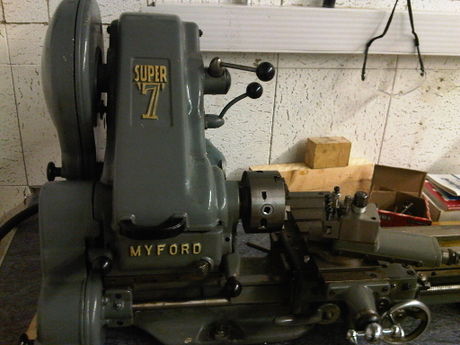Difference between revisions of "Equipment/Lathe"
MarkMellors (Talk | contribs) |
|||
| Line 81: | Line 81: | ||
== Peripheral tools and accessories == | == Peripheral tools and accessories == | ||
| + | Photo-list of current [[lathe accessories]]. | ||
Running the lathe will require many accessories, there is a suggested list here: | Running the lathe will require many accessories, there is a suggested list here: | ||
Revision as of 11:21, 3 April 2013
Equipment / Lathe
Contents
Summary
We have a Myford super 7 lathe kindly donated to us by Martin Levine. It is a quality machine in fair condition but it is capable of causing severe injury so it must only be used by those trained to operate it safely. The 'owners' are responsible for training new users and ensuring that it is maintained in a safe condition.
Using the lathe
The Myford is a metal turning lathe capable of machining round material up to about 18cm (7 inches) in diameter and about 45cm (18") long.
Safety
The workpiece is spun at high speed with great force. Clothing or hair caught in the workpiece will not slow the motor! Before starting take time to check there is nothing likely to be caught in the machine.
The chuck key left in the chuck when the motor is started could become a missile. Before starting the motor make sure the chuck, and anything mounted in it, will not hit anything.
Metal turnings have very sharp edges. Avoid touching them whenever possible and use the brush provided to clean up swarf.
To achieve real safety user attitude is key. Trying to achieve unrealistic goals in limited time is the prime cause of accidents. Please take the time to plan your work and gain sufficient knowledge to perform it safely.
Owners
The owners are experienced users who have volunteered to ensure members know how to safely operate the lathe before they become approved users. Their next responsibility is to ensure the lathe is in a safe usable condition. Time permitting, they will advise users on how to make best use of the lathe.
So far the owners are Roger Smith and Robert Copcutt.
Training
THE LATHE CAN CAUSE SERIOUS INJURY. ONLY APPROVED OPERATORS ARE PERMITTED TO USE IT.
To get the required training to become an approved operator please contact one of the owners.
The owners will help users make the best use of the lathe but it must be emphasised that learning to take full advantage of all the capabilities of it takes months of practice. The owners have limited time so members will need to take responsibility for much of their own training.
Instructions
There is a book, "Myford series 7 manual", by Ian Bradley available in the workshop (please do not remove it). We also a Lathe safety manual from the CRC. These provide a comprehensive guide to using the Myford. If you want to use the lathe, or simple know what it can do, please have a look at these publications - in Makespace.
Maintenance
The lathe bed should be frequently brushed clean and re-oiled to minimize wear on the slides.
There are several oil pots that need topping up occasionally.
Historical discussion on buying a new or used lathe
Large used lathes sell for cheap. They have the capacity to work large pieces, and they may be of very high quality for the price. Transporting them is difficult: they can weigh (literally) a ton. Getting spares when they arrive incomplete, they break, or we want accessories could be very difficult. Making a decision as a group about what to buy could be very difficult -- the used market is a moving target.
New lathes cost a lot, but there are entry level lathes of reasonable quality that would get us started. The downsides are a more limited capacity, and a less rigid machine. The small machines coming out of China dominate the small-lathe market, and buying one of these would make it easy to get spares and accessories from multiple sources. There is also an online community of hobbyists using them that we could draw upon. Chester, Machine-Mart, Axminster, and Arc Euro Trade all re-brand and sell very similar Chinese lathes.
Desirable Features
- Thread cutting
- Variable speed
- Quick change tool post
Concrete suggestions
The following small lathes have the features:
- http://www.chestermachinetools.com/products/detail/2 -- 332.50 ex. vat
- http://www.chestermachinetools.com/products/detail/3 -- 415.83 ex. vat
Joe says that these are rather small, and he knows, from experience, that they are easy to knock out of alignment. He recommends a bigger machine for beginners:
http://www.warco.co.uk/metal-lathes-metalworking-lathe-machine/19-wm280v-f-variable-speed-lathe.html -- 1,575.00 inc. VAT
(MT) That looks like a very good lathe. There still could be a place for a smaller, less expensive lathe in addition to a big lathe. If the Chester one is not a good choice for this, what about something like: http://www.warco.co.uk/metal-lathes-metalworking-lathe-machine/15-wm-180-variable-speed-lathe.html - 725.00 inc vat
And in the same spirit for a lower cost milling machine: http://www.warco.co.uk/milling-machines/36-major-milling-drilling-machine.html 1100.00 inc
Peripheral tools and accessories
Photo-list of current lathe accessories.
Running the lathe will require many accessories, there is a suggested list here:
http://www.mini-lathe.com/Mini_lathe/Accessories/accessories.htm
List desired accessories below:
- HSS tool blanks
- Tailstock chuck
- Vertical slide attachment (enables limited milling operations)
